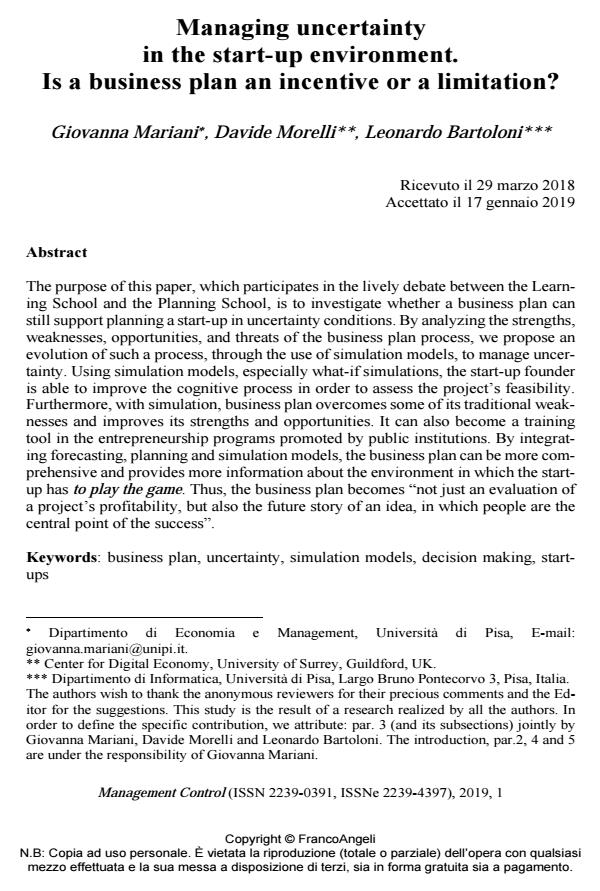Managing uncertainty in the start-up environment. Is a business plan an incentive or a limitation?
Journal title MANAGEMENT CONTROL
Author/s Giovanna Mariani, Davide Morelli, Leonardo Bartoloni
Publishing Year 2019 Issue 2019/1
Language Italian Pages 24 P. 73-96 File size 293 KB
DOI 10.3280/MACO2019-001004
DOI is like a bar code for intellectual property: to have more infomation
click here
Below, you can see the article first page
If you want to buy this article in PDF format, you can do it, following the instructions to buy download credits

FrancoAngeli is member of Publishers International Linking Association, Inc (PILA), a not-for-profit association which run the CrossRef service enabling links to and from online scholarly content.
The purpose of this paper, which participates in the lively debate between the Learning School and the Planning School, is to investigate whether a business plan can still support planning a start-up in uncertainty conditions. By analyzing the strengths, weaknesses, opportunities, and threats of the business plan process, we propose an evolution of such a process, through the use of simulation models, to manage uncertainty. Using simulation models, especially what-if simulations, the start-up founder is able to improve the cognitive process in order to assess the pro-ject’s feasibility. Furthermore, with simulation, business plan overcomes some of its traditional weaknesses and improves its strengths and opportunities. It can also become a training tool in the entrepreneurship programs promoted by public insti-tutions. By integrating forecasting, planning and simulation models, the business plan can be more comprehensive and provides more information about the envi-ronment in which the start-up has to play the game. Thus, the business plan be-comes "not just an evaluation of a project’s profitability, but also the future story of an idea, in which people are the central point of the success".
Keywords: Business plan, uncertainty, simulation models, decision making, start-ups
- Management accounting systems in venture capital-backed start-up companies Simone Aresu, Luigi Rombi, Andrea Cardia, in MANAGEMENT CONTROL 3/2019 pp.35
DOI: 10.3280/MACO2019-003003 - Cheating in the evaluation. An expedient to estimate the impact of intangibles on the enterprise value of the high-growth start-ups Giulia Cattafi, Giovanna Mariani, Francesco Pistolesi, Domenico Nicolò, in MANAGEMENT CONTROL 3/2024 pp.193
DOI: 10.3280/MACO2023-003009 - La relazione tra l'esperienza degli amministratori e il business plan: un'indagine empirica sulle imprese quotate in Italia Emmadonata Carbone, Sara Saggese, Fabrizia Sarto, in MANAGEMENT CONTROL 1/2023 pp.69
DOI: 10.3280/MACO2023-001004 - Developing a Conceptual Framework for Business Plan Drafting: Insights from Practitioners Paolo Roffia, in Administrative Sciences /2025 pp.113
DOI: 10.3390/admsci15030113 - Corporate reputation and social sustainability in the early stages of start-ups: A theoretical model to match stakeholders' expectations through corporate social commitment Maria Giuseppina Bruna, Domenico Nicolò, in Finance Research Letters 101508/2020 pp.101508
DOI: 10.1016/j.frl.2020.101508
Giovanna Mariani, Davide Morelli, Leonardo Bartoloni, Managing uncertainty in the start-up environment. Is a business plan an incentive or a limitation? in "MANAGEMENT CONTROL" 1/2019, pp 73-96, DOI: 10.3280/MACO2019-001004